Who would have thought that something so outrageously decadent as expensive chocolate might actually be good for you?
When Hernando Cortés and about 600 Spanish soldiers, the conquistadores, landed on the Yucatan peninsula of modern-day Mexico, the Aztecs (under the leadership of their King Montezuma) controlled all of the area. The Spanish wanted to convert the Aztecs to Christianity, but had also come to find gold and return it to Europe. Though vastly outnumbered, Cortés’ men had a terrible advantage that almost wiped out the Aztecs – viral disease. The Mesoamericans had no herd immunity to the diseases the conquistadores brought with them, likely to have been smallpox and measles, and so succumbed to the Spanish. Legend has it that the Aztecs valued the humble cocoa bean more highly than gold, and when the Spanish eventually broke into the treasure stores expecting to find gold, they found stores of cocoa beans instead.
The cacao tree grows in Central America, flourishing in the climate of persistent heat, humidity and high rainfall (not unlike Cairns). The Mexican climate was too dry, and the Aztecs traded to obtain the prized cocoa beans from the Mayans. Cacao is a Mayan word, meaning ‘God food’, and ‘cocoa’ is the European corruption of that word. Indeed, the Latin species name for the cocoa bush is Theobroma Cacao, literally ‘the food of the Gods’.
The Mayans and Aztecs consumed chocolate as a drink, after pulping and cooking the beans then mixing it with chili powder and some maize flour. The resulting mixture was subsequently allowed to ferment in ceramic containers. The residue of chocolate drinks has been found in Central America by archaeologists in earthenware dating more than a thousand years before the birth of Christ. Cortés and his men, when they first encountered ‘chocolate drinks’, were horrified by the brew, describing it as ‘unpleasant’ and ‘loathsome’. The Aztec name for the malodorous brew was xocolatl, which was pronounced as ‘chocolate’ by the Spanish. It was thought that xocolatl was an aphrodisiac, hence its prized place in Aztec society.
To make the mixture drinkable for the Europeans, the Spanish modified the recipe and mixed the pulped cocoa beans with sugar and vanilla beans. Once back on Spanish soil, the fermented beans were roasted then ground up like flour and thereafter exported. The fact that cocoa beans provided the raw material for cocoa powder was kept secret, much like the Coca Cola recipe or Colonel Sanders’ 11 secret herbs and spices are today. The story goes that buccaneers seized a heavily protected Spanish vessel, assuming it to be loaded with treasure. The holds were full of cocoa beans, which they mistook for sheep manure, prompting the raiders to scuttle the vessel in frustration, unaware that, by weight, cocoa beans were more valuable than silver at the time!
The spread of chocolate to the new world
Chocolate powder exported from Spain had spread around Europe and arrived in England in the 16th century. A splinter group from the Puritans of the English Civil War, the so-called Quakers, took to working with chocolate. The Quakers were a strictly pacifist group and preferred to work with food rather than in industries that could contribute to war. Many of the great names associated with chocolate manufacture – Rowntree, Cadbury and Fry – were Quaker families. The Quakers had a strong sense of social responsibility and, in contrast to many other industrialists of the era, took their responsibility to employees very seriously. The Cadbury family built an entire town, complete with a church, library, school and good-quality housing for their employees. The town was named Bourneville, a name we associate with cocoa powder to this day.
Many of the original colonies of North America – eventually becoming Canada and the USA – were established by conservative puritan Christians, who took the cocoa beans with them. At the time, processes for extracting the ‘bitter-tasting fat’ or cocoa butter were developed, to improve the palatability of the cocoa. It was not until the mid-19th century, though, before the first solid chocolate was manufactured by mixing sugar with cocoa powder in a cocoa butter base. This method of making solid chocolate was developed by Fry and Sons of Bristol in England.
What’s good for you?
It has long been recognised that foods such as red wine and green tea contain antioxidants with positive health effects. Cocoa beans also contain plentiful polyphenols, of which the sub-class of flavanols are particularly abundant in dark chocolate (chocolate that is rich in cocoa). However, it was not until the turn of the new century that researchers began to investigate whether the antioxidants in dark chocolate might impart the same health benefits as other antioxidant foods. Studies of dark chocolate yielded remarkable results, with a systematic review concluding that levels of chocolate consumption seem to correlate with a substantial reduction in the risk of cardiometabolic disorders.1
Flavonoids such as flavan-3-ol and their oligomeric derivatives, procyanidins, are present in high concentration in cocoa and dark chocolate products. Consumption of dark chocolate by healthy subjects has been associated with ‘a beneficial effect on endothelial function in healthy adults.’2 Similar studies in smokers have shown that dark chocolate induces a rapid and significant improvement in endothelial and platelet function in healthy smokers up to eight hours after ingestion.3 Those authors attributed these effects to the antioxidant effect of dark chocolate, including reduction in platelet activation. A similar study by Engler and colleagues reported that flavonoid-rich dark chocolate improved endothelium-dependent vasodilatation in healthy adults.4
The flavanols in dark chocolate have been shown to deactivate free radicals and also stimulate release of nitric oxide (NO), a potent vasodilator, from vascular endothelium. It also seems that they reduce low density lipoprotein (LDL) oxidation by neutralising free radicals, and may help prevent endothelial injury that is associated with plaque formation. Dark chocolate has also been found to have a similar effect to low-dose aspirin on arterial place thrombus formation.
Chocolate and pre-eclampsia
Although the pathophysiological basis of pre-eclampsia (PE) remains incompletely understood, a number of key physiological abnormalities have been identified and these will be of interest to chocolate lovers. In the first instance, PE is more common in pregnancies with increased placental oxygen demand (for example, multiple pregnancy, rapidly growing hydatidiform moles and hydropic placenta). Similarly, when there is decreased oxygen transfer the incidence of PE increases (microvascular diseases such as chronic hypertension, diabetes and collagen-vascular diseases). It is important that the primigravid uterus has a less well-developed vasculature than in multigravid women.

Food of the gods it might well be, but can eating high-quality dark chocolate during pregnancy help prevent pre-eclampsia?
In normal pregnancy, the end of the first trimester is characterised by invasion of cytotrophoblastic tissue through the basal decidua to the inner myometrium. There are marked morphological changes to the spiral arterioles in the intervillous spaces. The arterioles are converted to large, tortuous sinusoidal vessels. The endothelium and internal elastic lamina is replaced by trophoblast and amorphous matrix containing fibrin.5 The morphological changes mark conversion of the placental vascular supply to a ‘low-pressure, high-flow’ system. In PE, these arteriolar changes either do not occur or are limited to vessels located in the decidua. This ‘failure of endovascular trophoblastic infiltration’ results in the uteroplacental arteries maintaining their musculo-elastic architecture and responsiveness to vasomotor influences.6
The endothelium is an epithelial monolayer, in direct contact with the blood. The endothelium has many known functions, including modulation of vascular smooth muscle reactivity in response to stimuli. The endothelial cells synthesise various substances. These include small molecules such as NO, platelet activating factor (PAF), endothelin and prostacyclin (PGI2). Nitric oxide and PGI2 are particularly important, as these normally inhibit platelet adhesion to the endothelium.7
Pre-eclampsia is associated with abnormal endothelial cell function, with the consequences of activation of the coagulation cascade and fluid extravasation (resulting from breakdown in the endothelial barrier) and increased pressor effects of vasoactive substances. Endothelial synthesis of PGI2 and NO is reduced in women with PE.8 It is postulated that dysfunctional endothelium activates platelets with consequent release of thromboxane (TXA), resulting in an abnormal ratio of TXA:PGI2 that would enhance relative or absolute vasoconstriction.7 Taken together with results of studies of a large number of other vasoactive substances, it is likely that ‘endothelial cell dysfunction may be the cause rather than the consequence of the increased blood pressure observed in pre-eclampsia.’5 Indeed, since endothelium is ubiquitous, it would explain the multisystem nature of the manifestations of PE.9 There is evidence for impairment of endothelium-dependent relaxation of myometrial arteries in PE. As well, platelet activation is increased in PE, associated with relative thrombocytopaenia and increased mean platelet volume (as younger platelets are released into the circulation).9
With these physiological mechanisms in mind, a number of attempts have been made to reduce the incidence of PE. These are reviewed in detail by Visser and Wallenburg10 and include lifestyle interventions, and dietary restrictions (salt, for example). Systematic review and meta-analysis of pooled data from trials of aspirin suggests that ‘low-dose aspirin is mildly beneficial in the prevention of pre-eclampsia in high-risk women, but no beneficial effect was observed in women at low risk of developing pre-eclampsia.’11
Since PE is associated with widespread endothelial dysfunction, would consumption of flavonoid-rich dark chocolate (which has a broad effect to improve ‘endothelial dysfunction’ and reduce platelet activation) be expected to have a similar, or indeed superior, effect to that shown in trials of low-dose aspirin in reducing the primary incidence of PE in low-risk populations? A recent prospective cohort study examined the amount of chocolate consumed by pregnant women and found that increased chocolate intake in the first trimester was associated with reduced odds of gestational hypertension, with an adjusted odds ratio of 0.65 (95 per cent CI: 0.45, 0.87), which seems to be a dramatic decrease.12
With these findings in mind, we are currently undertaking a pilot study of dark chocolate in early pregnancy. Among the issues we are trying to iron out are whether women will be too nauseated to eat 25mg of dark chocolate each day and how to stop women in the control arm from simply going to a supermarket and buying chocolate.
A guilty pleasure
How delightful it is that something so outrageously decadent as dark chocolate might have positive benefits. From its bloody history in the jungles of Central America, to the antenatal clinics of Cairns and Canberra, the lure of the ‘food of the Gods’ continues.
References
- Buiotrago-Lopez A, Sanderson J, Johnson L, et al. Chocolate consumption and cardiometabolic disorders: systematic review and meta-analysis. BMJ 2011; 343: d4488.
- Vlachopoulos C, Aznaouridis K, Alexopoulos N, et al. Effect of dark chocolate on arterial function in healthy individuals. Am J Hypertension 2005; 18: 785-91.
- Hermann R, Spieker LE, Ruschitzka R, et al. Dark chocolate improves endothelial and platelet function. Heart 2006; 92: 119-20.
- Engler MB, Engler MM, Chen CY, et al. Flavonoid-rich dark chocolate improves endothelial function and increases plasma epicatechin concentrations in healthy adults. J Am Coll Nutr 2004; 23: 197-204.
- Salas SP. What causes pre-eclampsia? Clin Obstet Gynaecol 1999;13: 41-57.
- Bernheim J. Hypertension in pregnancy. Nephron 1997; 76: 254-63.
- Dekker GA, van Geijn HP. Endothelial dysfunction in preeclampsia.Part 1: primary prevention. Therapeutic perspectives. J Perinatal Med 1996; 24: 99-117.
- Seligman S, Buyon J, Clancy R, et al. The role of nitric oxide in the pathogenesis of preeclampsia. Am J Obstet Gynecol 1994; 171:455-8.
- Kenny L, Baker PN. Maternal pathophysiology in pre-eclampsia. Clin Obstet Gynaecol 1999; 13: 59-75.
- Visser W, Wallenburg HCS. Prediction and prevention of pregnancy induced hypertensive disorders. Clin Obstet Gynaecol 1999; 13:131-56.
- Ruano R, Fontes R S, Zugaib M. Prevention of preeclampsia with low-dose aspirin: a systematic review and meta-analysis of the main randomized controlled trials. Clinics 2005; 60: 407-414.
- Saftlas AF, Triche EW, Beydoun H. Does chocolate intake during pregnancy reduce the risks of pre-eclampsia and gestational hypertension. Ann Epidemiol 2010; 20: 584–591.






Leave a Reply